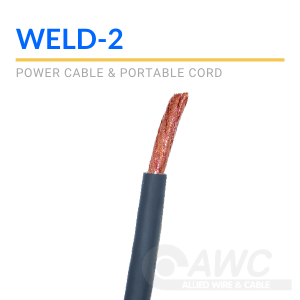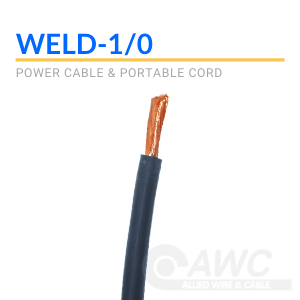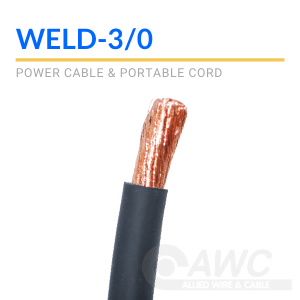What are Class K welding cables?
Class K welding cables are standard welding cables constructed as single-core insulated cables in a relatively large-diameter designed to be used to connect welding machines, welding electrodes, ground clamps, and automated welding heads. Cables usually, but not always, have different colors so users can distinguish between the live wire and the ground wire. Welding cables have great flexibility and are soft but have strong abrasion- and oil-resistant insulation. Class K welding cables are rated at 600 volts. These welding cables come in a range of colors including red, black, orange, yellow, green, and blue.
13 items
-
WELD 4 SUPERVUTRN$0.00 / 50 FT
- Approx LBS/MFT: 184
- AWG Size: 4
- Cond. Material: Bare Copper
Additional Information
What type of conductors are used for Class K welding cables?
Class K welding cables are standard welding cables that feature multiple strands of 30 American Wire Gauge (AWG) pure copper wire. With a strand diameter of only 10 thousandths of an inch, class K welding cables are flexible and kink-resistant. Because of the many fine copper strands in the conductor, it's best to use crimped cable connectors and lugs for connecting welding cables to equipment.
What type of insulation does Class K welding cable have?
Class K welding cable insulation is ethylene propylene diene monomer (EPDM) synthetic rubber. EPDM rubber has excellent abrasion- and tear-resistance. It is resistant to oils, greases, solvents, water-based chemicals, and atmospheric aging. The material is a good insulator, is flexible over a wide range of temperatures, and has minimal shrink back when cut. The cables have a paper separator between the conductor and insulation to minimize friction between the conductor and insulation when manipulating welding cable.
Are there different types of welding cable?
Besides Class K welding cable, AWC carries Class M welding cables supplied as part of the General Cable Carol cable range. When compared to Class K welding cables, Class M cables have thinner 34 AWG copper wire strands for increased flexibility. The cable has a proprietary and stronger Super Vu-Tron Supreme synthetic rubber insulation. This is a durable material able to withstand extensive flexing. It has good resistance to oils, chemicals, atmospheric aging, and excellent low- and high-temperature properties.
What are the primary applications of welding cable?
The primary use for welding cables is to connect the secondary (welding) circuits of AC and DC welding machines, especially stationary welders with long leads. Because welding cables have a 600-volt rating, you can use them as portable power cables. You may use welding cables in place of battery cables, especially for starting and winching applications, although it's essential to secure them properly to prevent the cable from rubbing against vehicle bodywork.
How do I choose the right welding cable?
The size of the welding cable should be chosen based on a combination of the amperage of the welding machine and the cable run length. You must select a cable that is large enough to handle the current required for the welding machine. Using a smaller cable than is required could result in overheating and possibly dangerous conditions. For best welder performance, you need to ensure your welder delivers sufficient current and voltage at the workplace. Check your welding cable is large enough for the maximum current from your welding machine. Determine this from the AWC Ampacities and Correction Factors Tables. As a general guide, you'll need a 2/0 AWG wire with an approximate outside diameter of just over half an inch for welding at 250 amps. If you're using long cables, make allowance for the voltage drop as this adversely affects welding quality.
Are there alternatives to using welding cable?
When it comes to high current applications, two alternatives stand out; diesel locomotive (DLO) cable and battery cable.
DLO Cable
Diesel locomotive cable is a rugged, reliable, and flexible cable with an EPDM insulation and chlorinated polyethylene (CPE) jacket. DLO cable is more robust than welding cable and can handle up to 2000 volts. The conductor has fewer but thicker wire strands so the cable isn't as flexible. You can use a DLO cable for welding. Visit our Allied University to learn more about the differences between welding cable vs. DLO cable or contact us today.
Battery Cable
Battery cables have a maximum rated voltage of 60 volts, so they aren't suitable for welding because the open-circuit voltage of welders exceeds 60 volts. The wire uses thicker strands, and compared to DLO and welding cable, is relatively inflexible. While battery cable isn't suitable for welding, you can use welding cable for battery connections. Visit our Allied University to learn more about the differences between welding cable vs. battery cable or contact us today.
What is the difference between welding cable and regular cable?
The key differences between welding cable and regular cable are the aspects that make welding cable suitable for the specific application of welding. Welding cables are designed to be highly flexible and maneuverable while able to handle high electrical currents with minimal voltage drops and heat buildup. Welding cable also is more durable due to it's superior insulation and jacketing that protects it from exposure to sparks and flames. Although welding wire can be more flexible and durable than regular cable, it should be highlighted that welding cable should be exclusively used to welding and not for general electrical purposes. It is crucial to always follow relevant safety guidelines, standards, and regulations to ensure compliance and safety when choosing wire for your specific application.
What does the ampacity of welding cable pertain to?
The ampacity of welding cable is a figure that indicates the amount of electrical current that the cable can safely carry. Welding cable ampacity of welding cable is generally higher than that of regular electrical cable, as it welding often requires higher current than other applications.
How do I maintain my welding cable?
Proper care and maintenance of welding cable will ensure that it lasts a long time and continues to be safe to use. All welding cable users should protect their cable from damage, such as by using cable covers or storing it properly, and inspecting it regularly for signs of wear or damage.
Class K Welding Cable Properties
| Conductor: | 30 AWG stranded copper conductors |
| Sizes: | 6 AWG to 500 MCM |
| Insulation: | EPDM |
| Maximum Voltage: | 600 volts |
| Usable Temperature Range: | -50°C to 105°C |
| Colors: | Red, Black, Orange, Yellow, Green, and Blue |
| SAE Compliance: | 6 AWG to 250 MCM comply with SAE J1127 |








